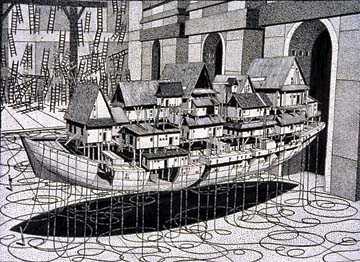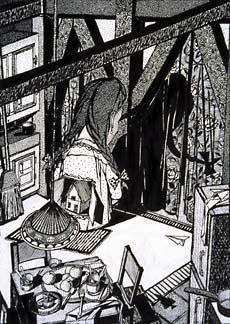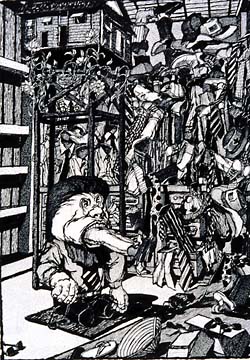
Current Issue Highlights More Readings DA Home About Direct Art

In 1979, at the age of seven, Duat Vu and his family escaped Vietnam by boat. They nearly died on the trip. The boats used to cross the ocean at that time were as small as three by ten feet. His family was on a larger one, approximately 14 feet wide and 60 feet long. It carried about 380 people, men, women, children and babies. Duat describes the experience in a few sentences:
"The geographical landscape underneath the ocean is like that on land. There are mountains, hills, valleys, and plateaus. Our boat got stuck, literally, on a jagged, rocky plateau that was 3 feet under the surface of the ocean. The small boat tipped to one side and stuck in the middle of the sea. Everywhere we looked we saw nothing, only a flat horizon where the ocean met the sky. We were stuck for 10 days with scant food and water. People died of thirst, of starvation, of dehydration. People died when the roof of the boat caved in. People died drowning. People died when they ventured out on inflatable rafts and wooden planks to seek help and never returned. To keep it short, we got off the plateau on our own eventually."
Duat’s work is about his experience as an immigrant, a survivor of a transpacific boat trip, a conflicted identity of eastern and western influences and ultimately the Vietnam war. His life experiences have created a complex emotional state of being that he tries to unravel in his work.
 |
This drawing is called Immigrant Woman: Choosing Pillars of Salt
(ink on paper 15" x 11"). It is about my sister, mother, aunt and all
Vietnamese women who are bound by tradition. I see them as the pillars of the immigrant
family. Being a pillar can also be burdensome and often they are unappreciated. Why a pillar of salt? There are salt in tears, sweat and blood. The picture shows a girl with her back revealing a house, her desire to have a family of her own. On either side are entrances, one represents her parents’ family, one represents her future, and yet she hesitates to choose knowing in either choice she is probably still a pillar of salt. |
Canadians have fur coats, because the weather is cold. Vietnamese dress the way they do because of the tropical climate. Culture is not just about holidays or festivals, the highlights of literature or music. More often culture is the mundane, everyday thing, the food we eat, the language we hear and speak. The Canadian diet is different from the Vietnamese because of the soil and the native plants. Culture, whatever it may be, is unquestionably also a result of the interaction between a group of people and the land they live on.
Often I asked my father as I ask myself, how can we preserve Vietnamese culture, when we are no longer living in Vietnam? Without our land, the culture we preserve has lost its context. It is in limbo, caught between space and time. It is beautiful and yet artificial like decoration.
Every house must have its own decoration, for decoration announces who and what we are. Hence the floral patterns, the decorative style and decorative elements you see in my drawings represent this sad realization. They stand for the culture and ethnicity of immigrants. They are beautiful. They are necessary, but they are also rootless.
I examine the root of my identity. Where does it lie? In my nationality, my ethnicity, my culture, my genes? Culture cannot be inherited. So what is my root? It is just a starting point.

Immigrants- Songs of My Homeland Ink on paper 11" x
15"
War is full of paradoxes; it liberates, but it also destroys; it aspires to higher ideals, but at the price of oppressing others; its heroes are also the villains to the losing side; its triumphant victories are also tragedies. Hence the scenes in my pictures are about celebration and oppression at the same time.

Immigrants– Trying Out Different Legs Ink
on paper 15" x 11"
Duat Vu: duv898f@smsu.edu
Current Issue Highlights More Readings DA Home About Direct Art